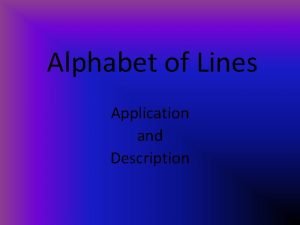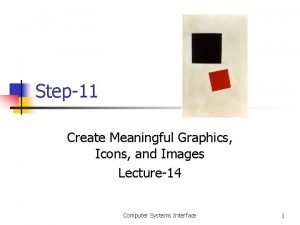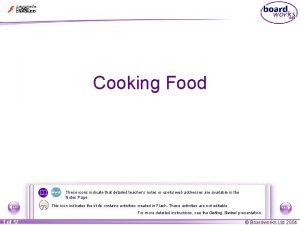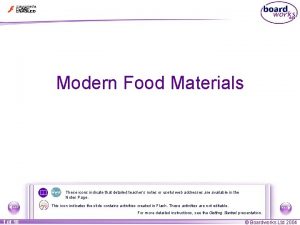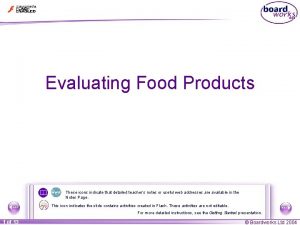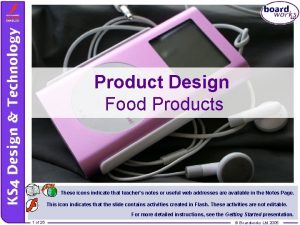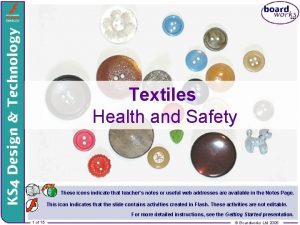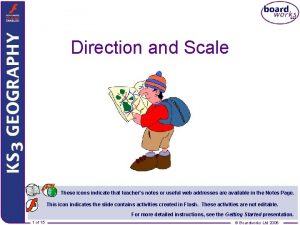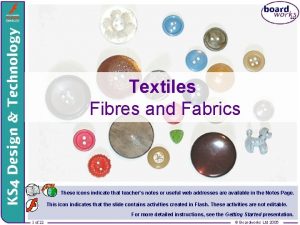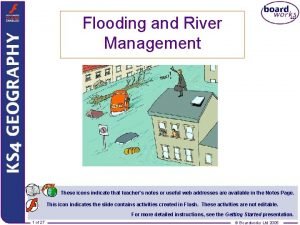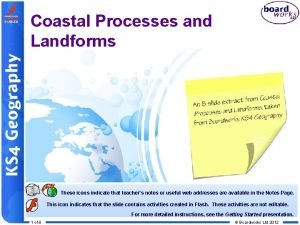Food Types and Properties These icons indicate that
















- Slides: 16

Food Types and Properties These icons indicate that detailed teacher’s notes or useful web addresses are available in the Notes Page. icon indicates slide contains Flash. These activities are not editable. This icon. This indicates the slide the contains activities created increated Flash. in These activities are not editable. For more detailed instructions, see the Getting Started presentation. 1 of 16 © Boardworks Ltd 2004

Making a cake 2 of 16 © Boardworks Ltd 2004

Changing the recipe Recipes for baked foods like cakes and pastries and bread have to be followed carefully: too much flour will make the cake dry too much fat will stop it rising too much sugar will affect its texture. We can add flavouring ingredients like lemon zest or cocoa power, but we have to keep the proportions of the ingredients the same. For a Victoria Sponge, that’s equal weights of eggs, fat, sugar and flour. 3 of 16 © Boardworks Ltd 2004

Function of ingredients Ingredients in recipes are there for a reason. They have a particular function: physical – affects the structure of the food – the flour in the cake set the foam and held the cake together sensory – gives colour, flavour or texture – the sugar in the cake made it taste sweet nutritional – added for its food value – eggs are a source of protein. 4 of 16 © Boardworks Ltd 2004

Function of carbohydrates Dextrinization – when starch is baked it changes colour, flavour and smell. For example, bread becomes toast. Caramelization – when sugar is heated until it melts, it changes to caramel, which gives chewiness, sweetness and flavour. Gelatinization – when starch is mixed with water and heated, the starch grains swell and absorb the liquid. The mixture thickens, as in a blancmange. Flavouring – sugar makes food taste sweet. Preserving – jams are made with lots of sugar and this can prevent micro-organisms growing. 5 of 16 © Boardworks Ltd 2004

Function of proteins – coagulation What’s happening here? Raw eggs are runny, but when they are cooked the white changes colour and become solid. This is called coagulation. The heat makes the proteins in the egg uncoil and form a solid structure. 6 of 16 © Boardworks Ltd 2004

Uses of coagulation 7 of 16 © Boardworks Ltd 2004

Gluten is made when proteins from wheat flour are mixed with water. It is important when making bread. Kneading dough untangles the protein strands and develops the gluten. The gluten is strong and elastic, and holds the bread together. Gluten traps the gases that form in bread when you cook it. Strong flour has more gluten, and so is better for making bread than ordinary flour. 8 of 16 © Boardworks Ltd 2004

Gelatine is a protein that can be used to set foods. Gelatine is extracted from the connective tissue in meat. When you make a jelly, you mix gelatine with warm water, which makes the protein chains unfold. As the jelly cools, the proteins form a network and the jelly sets. If you heat the jelly up it will become a liquid again. 9 of 16 © Boardworks Ltd 2004

Function of fats Shortening – fat coats the particles of flour and stops it absorbing water, so gluten does not develop and texture stays crumbly. Plasticity – some fats are solid at room temperature, some are liquid. Aeration – creaming fat with sugar makes air bubbles. Flakiness – flaky pastry uses fat to keep layers of starch separate. 10 of 16 © Boardworks Ltd 2004

Emulsions Oils and water don’t usually mix. If you mix them up, they separate out again. If you want to keep the oil and water mixed, you have to add an emulsifying agent. Mayonnaise is a mixture of oil and vinegar. Egg yolk is added to make the mixture into an emulsion and stop it separating. 11 of 16 © Boardworks Ltd 2004

Food additives Additives are substances that are added to food when it is processed. Some are natural, others are man-made. Some are used to make the food look nice, such as colourings. Preservatives are added to make the food keep longer. They can be added for other reasons, such as adding flavour or improving texture. New additives have to be checked for safety before they can be used. 12 of 16 © Boardworks Ltd 2004

E numbers All food additives are given a code called an E number. E 100– 199 add colour to your food. E 200– 299 preserve food and increase its shelf life. E 300– 321 are anti-oxidants and stop fat going rancid. E 322– 321 are emulsifiers to stop oil and water separating. 13 of 16 © Boardworks Ltd 2004

Herbs and spices are not usually added to food for their nutrition value, but because they make it taste and smell nice. Pilau rice can contain spices like cardamom and cloves which add flavour and make the rice smell wonderful. Herbs like parsley, mint and coriander can be bought while they are still growing, so that they can be cut fresh and full of flavour. Dried herbs and spices have a more intense flavour, so you don’t need to use as much of them. 14 of 16 © Boardworks Ltd 2004

Match them up 15 of 16 © Boardworks Ltd 2004

Summary Starches add bulk to food, and can be used as thickeners. Sugar adds sweetness, colour and flavouring and can be caramelized. Fat traps air when it is beaten with sugar. It also shortens foods to give a crumbly texture and makes mixtures feel moist when eaten. Proteins trap air when they are whisked into a foam. The protein in egg white coagulates and sets when heated. Gluten is a protein found in wheat and is important when making bread. 16 of 16 © Boardworks Ltd 2004
 Represents a surface not visible in the view drawn
Represents a surface not visible in the view drawn Phân độ lown ngoại tâm thu
Phân độ lown ngoại tâm thu Block nhĩ thất độ 1
Block nhĩ thất độ 1 Thơ thất ngôn tứ tuyệt đường luật
Thơ thất ngôn tứ tuyệt đường luật Thơ thất ngôn tứ tuyệt đường luật
Thơ thất ngôn tứ tuyệt đường luật Chiến lược kinh doanh quốc tế của walmart
Chiến lược kinh doanh quốc tế của walmart Tìm vết của đường thẳng
Tìm vết của đường thẳng Con hãy đưa tay khi thấy người vấp ngã
Con hãy đưa tay khi thấy người vấp ngã Tôn thất thuyết là ai
Tôn thất thuyết là ai Gây tê cơ vuông thắt lưng
Gây tê cơ vuông thắt lưng Sau thất bại ở hồ điển triệt
Sau thất bại ở hồ điển triệt Clouds fog or dew will always form when
Clouds fog or dew will always form when Unit 2 food food food
Unit 2 food food food Sequence of food chain
Sequence of food chain Extensive vs intensive
Extensive vs intensive Chemical properties of citric acid
Chemical properties of citric acid Meaningful graphics
Meaningful graphics
